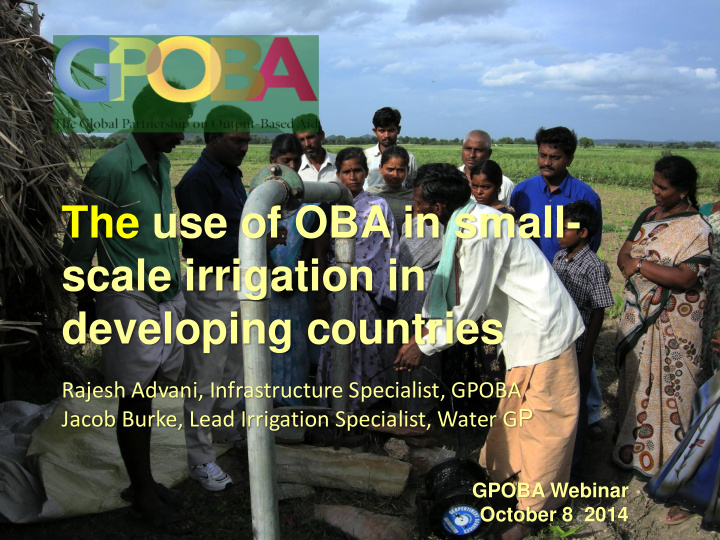



The use of OBA in small- scale irrigation in developing countries Rajesh Advani, Infrastructure Specialist, GPOBA Jacob Burke, Lead Irrigation Specialist, Water G P GPOBA Webinar October 8 2014
Introduction Objectives 1. Evaluate the scope for OBA in financing small-scale irrigation schemes to support poor farmers in developing countries 2. Propose design and implementation arrangements for possible OBA schemes Country focus Bangladesh, India (Madhya Pradesh & Orissa), Ghana, Kenya, Zambia.
Report Outputs Main Report – results of in-country consultations (India, Zambia) Annex A: OBA financial model user guide Annex B: Review of OBA approach and case studies Annex C: Country studies for desk-based review • Ghana • Kenya • Zambia • Bangladesh • India – Madhya Pradesh, Orissa
Scope to apply OBA in the irrigation sector 1. Sector Fit 2. M&E, 3. Scope for 4. Financial Implementation subsidies and sustainability of Government policies grants the sector generally consistent Irrigation projects with OBA principles have employed 3 rd Possible to levy Demand is evident – parties to verify irrigation service a step-up approach. outputs (Karnataka) charges. Concerns: Provider Concerns: Concerns: Concerns: Capacity pre-financing; sector Potentially difficult to Typically set too low of govts. and WUAs bureaucracy; subsidy measure delivery of to cover O&M costs; to manage an OBA administration in irrigation service collection difficulties contract. India Overall assessment There is scope to apply OBA to boos small holder irrigation - but in conjunction with other on-farm investments and extension support. The independently verifiable output is not just the delivery of a water service (unlike WSS or energy utilities). The technology application and producer price margin in irrigated crops needs to be clear from the outset.
Assessment of project opportunities India and Zambia India • Use of Market-based approaches • Integrated Micro-irrigation projects • Rainwater harvesting tanks Zambia • Commercial hub and out- grower models
India: market-based approaches – treadle pump based OBA GPOBA INTERNATIONAL subsidy DEVELOPMENT Reporting ENTERPRISES INDIA (IDEI) Supply-chain partners produce and then market products IVA Cash Payments Smallholder farmers Indicators Indicative costs/ outputs Indicative OBA grant $10m Funding gap Approx. $75/farmer Impact on farmers’ income Up by approx. $400 per year Key risks Pre-financing ability of NGOs
India: Integrated Micro-Irrigation Projects (IMIP) Indicators Indicative costs/ outputs Farmers Electricity & water charges Indicative OBA grant $5m to $10m Contribution to costs of micro- Funding gap Approx. $800 - $1,600 irrigation technology Impact on farmers’ Up by approx. $550 per ha income per annum Water Users’ Association Water use efficiency Improve by 45% to 60% Organize Farmers Collect fees from farmers Key risks Relies on counterpart funding from state governments. Private Partners IVA • Pre-finance, develop, operate & maintain infrastructure • Provide training to WUA & farmers Government • Concession agreement with private partner Electricity Board Water Board • Payments • Handover Land
India: Rainwater Harvesting Tanks Loan Commercial Smallholder Farmers (pre-finance) Bank Implementation Support NGO OBA GPOBA subsidy i.e. Pradan Reporting Verification IVA Indicators Indicative costs/ outputs Indicative OBA grant Approx. $9m Funding gap $890 – lower if additional support from government Impact on farmers’ income Increase up to $222 per farmer per year, and $400 after loan repaid Key risks Level of smallholder farmer demand and ability of NGOs to pre-finance.
Project opportunities for OBA support in Zambia Sugar Sugar Factory OBA GPOBA subsidy Reporting KEDE Ltd (JV – 3 comm. farmers) Provides Irrigation pre-finance Services & Off-take Manage IVA Sugar Smallholder Farmers Indicators Indicative costs/ outputs Indicative OBA grant $5m Funding gap $5,000 - $25,000 Impact on farmers’ income Increase up to $1,350 per hectare per annum • Key Risks High cost per farmer • Incentives for private firms to continue providing on-going support to small farmers until market fully develops
Issues Linkage with a viable crop model. • Is crop responsive/suited to the choice of irrigation technology? • Are production costs/producer prices viable in the long term? • Are all the other inputs (including extension) reliable? Technology choice and scaling • Standards….are there any?. • Quality assurance – pumps, pipe fittings, emitters? • Service/spare parts provision – is the market large enough? How to keep it simple for the IVA • More than verification of a functioning tap and water meter • One-off inspection or more? • What about complex contractual agreements?
Conclusions Market-based approaches for a range of micro-irrigation technology and rainwater harvesting tanks are potentially good candidates for OBA funds. • Successful at supporting large numbers of small farmers. • Less complex to implement and private service providers more agile. • Risk: need to assess appetite of private sector for OBA financing – specifically the structure of outputs and link to indicators, such as long term improvements in land productivity. Opportunities for OBA funds to support larger scale interventions would need to be structured carefully • IMIP approach offers an innovative opportunity to support small farmers in India. Risk: Complexities of working with State governments and limited time-frame of OBA intervention. • Commercial hub-outgrower models offer another opportunity. Risks: Incentives for larger farmers to continue ongoing provision of irrigation services to smallholder farmers. Funding gap is large.
Next steps Deep dive analysis of project opportunities. Further analysis of risk appetite for linking OBA subsidy disbursements to verification that the productivity has improved - particularly where private sector provider has limited control on farmer output. Scope for project funding over 3- 5 year timeline, given consultants’ recommendations of longer involvement for GPOBA for larger-scale opportunities. Develop concept note for OBA financing for most viable opportunity and where there is strong demand from clients and government, and sector/ country fit for the Bank and donors.
Recommend
More recommend